Textile retailers worked cohesively to produce fashionable luxury garments. Mantua-makers and milliners worked to design and create the gowns, whilst drapers and haberdashers provided fabrics and ready-made goods necessary for their completion.
Aware of the visual and tactile appeal of their wares, drapers in particular became adept at showcasing their stock. Floor to ceiling open presses displayed bolts of cloth whilst long lengths of fabrics were hung from hooks near the ceiling. Lace men, milliners and haberdashers also used ‘show boards’ to display their wares, whilst smaller items such as ribbons and threads were presented in nests of drawers or elaborately decorated boxes. One eighteenth-century shopper commented that this emphasis on display gave drapers’ shops the appearance of ‘perfect gilded theatres’. The open display of items, complemented with artificial lighting actively encouraged customers to feel the rich textures and experience the delicacy of the weaves. Tourist and commentator Andre Rouquet noted in 1755 how the lamps, candlesticks and sconces used in drapers’ shops created a ‘theatrical effect, of a most agreeable vista’.
This created a perfect atmosphere to see and be seen, to hear the latest gossip and news, and to see the latest fashions. The shops acted as a social hub where purchasing goods was not the only goal. To make customers feel more comfortable whilst browsing (and encourage a longer visit) many drapers provided comfortable and attractive upholstered chairs. One contributor to The Female Tatler claimed it was possible to ‘pass away three or four hours’ in ‘agreeable amusement’.
However, for wealthy customers shopping for fashion did not necessarily mean a trip to the shop. Retailers brought samples of fabrics and patterns into the houses of the elite, hoping to secure valuable custom and commissions. Historian Serena Dyer relates the example of Lady Mary Coke, who wanted a birthday gown created in 1767. She wrote ‘the weather as severe as ever, sent for the lace man & chose some silver lace to trim my gown’. She also ‘sent for the mercer to bring the silk for my Birthday Gown’. Advancements in sales techniques gave fabric retailers the convenience of bringing portable samples to customers themselves, allowing the very wealthy to be catered to in a manner they expected.
Further reading:
Serena Dyer, ‘Shopping, spectacle and the senses: fashion retail in Georgian England’, History Today, Vol. 65, No. 3, 2015.
Jon Stobart, Andrew Hann and Victoria Morgan, Spaces of Consumption: Leisure and Shopping in the English Town, c.1680-1830, Routledge, 2007.
Amanda Vickery, The Gentleman’s Daughter: Women’s Lives in Georgian England, Yale University Press, 1997.

